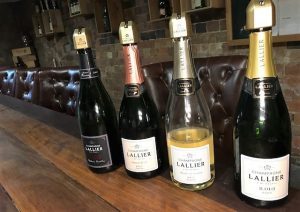
Five Reasons Why You Have To Taste Champagne Lallier From Constance Delaire… The Actual Winemaker!
Champagne Lallier…. Five reasons to taste Champagne Lallier from Constance Delaire… winemaker and brand ambassador.

Does Constance Delaire, wine maker and brand ambassador for Champagne Lallier, have the best job in the world?
Probably! And she knows she has an awesome job, because I made the mistake of asking her what she liked ‘most’ about her job. (Which was a very silly question… she works in Champagne, surrounded by champagnes all day and I ask her to pick one thing?????)
“Obviously I love travelling, and speaking about champagne and the brand, but I wanted to find a work where I could participate during the harvest and blend,” Constance explains.
Because participating in the harvest and the blend is the ultimate in winemaking, where Constance can really contribute to making the wines and their identity.
And then she gets to travel the world explaining why Champagne Lallier’s identity is so special.
“I love to travel and explain why it is a good quality champagne, talk about the aroma of this Champagne and why you have to taste Champagne Lallier. And not just be focused on big brands, because you have so many wines and Champagnes to taste so… just taste everything.”
And since she brought it up, we did taste Champagne Lallier. And for each wine, Constance explained what made it unique and special. And where she says something is unique, it is! She introduced some techniques that I hadn’t heard about before trying Champagne Lallier.
From talking to Constance, I’ve highlighted…
Constance explains…
“We are located in Aÿ, it was founded in 1906 by René Lallier, and in 1936 Aÿ was certified as Grand Cru. And you have just seventeen villages certified as Grand Cru (in all of Champagne), and it’s just 5% of the production in Champagne.
So it’s a very good sign of quality when you produce your wine from only the Grand Cru areas. We are very focused on Grand Cru, so we always want to select the cream of the crop — we say “la crème de la crème.
For that, we just work with Chardonnay and Pinot Noir, because you don’t have Pinot Meunier in Grand Cru villages. The Pinot Noir brings the full body and the Chardonnay adds a nice freshness and the minerality.
But when it’s mature, you’re going to bring also some creamy aroma, brioche aroma, so it’s very elegant, and very good champagne as well.”
Which as well as tasting unique, is also good for anyone who is Sulphur sensitive.
“It’s a wild yeast, in fact, and comes from one of our best parcel in … we call it Loridon, it’s in Aÿ. Normally, for the yeast, you can buy it at the laboratory. It’s a good yeast also, but that can change the taste of your wine. For red, for example, you can buy some yeast, you’re going to develop a more fruity aroma. If you use your own yeast, from one of our parcel, it’s our own yeast, our own terroir, it’s a unique taste.
“Because wild yeast produces natural sulphur, we will use less sulphur in our Champagne, so it’s always better. And it’s very important because many persons are very sensitive about sulphur and – me, I know I am – so for this wine, we put definitely less compared to Champagne houses elsewhere.”
“For all the range, we always use a subtle dosage. Because when you add sugar, you’re going to change the taste of your wine. And for us, we don’t want to change the taste of our wine. We really want to keep the terroir taste… it’s our style, our taste.”
“Normally for Brut non-vintage, you put in 30 or 40% of reserve wines so every year you get the same product. Us, we want to work our Champagne as wine, because at the beginning it is wine. We put at least 80% from the grape of the year, and less than 20% of reserves wine, so it’s like a small vintage in fact. For example, in the R.013, we would put 83% of the grape from 2013. We want to create a new non-vintage Brut every year so you can do a vertical tasting, like for wine. We are the only house to do it, so it’s really interesting, and it’s very important.”
“For this Blanc de Blancs, 60% of the grapes come from Aÿ. Normally it’s a terroir for Pinot Noir so you will have Chardonnay that is more round and more rich. And the other 40% of Chardonnay grapes come from La Côte des Blancs.”
“For this one, we invented a new method. We call it “mille-feuille” (which is a dessert in France). It’s just Pinot Noir and Chardonnay of course. We crush the grape and we put them directly in the vat, Pinot Noir, Chardonnay, Pinot Noir, Chardonnay in different layers, so it’s like the dessert. And with a warm temperature, just a couple of hours because we want to extract a nice salmon colour because we don’t want to extract too much tannin or colour. And bitterness, because we don’t like bitterness. For this one, it’s very elegant. You can smell nice fruity notes like wild strawberry. You have a nice minerality as well with the Chardonnay.”
“Normally, a vintage is aged at least five years on lees. But this one, it was aged nine years. All the grapes come from 2008, and we put in this one 45% of Chardonnay, and 55% of Pinot Noir. On the vintage we put a little bit more Chardonnay, because we will have more acidity, and more freshness, and it’s very important to have a nice acidity and freshness as well if you want to age your wine. It’s more powerful, has more complexity, and you have a deeper note of maturity. It has more honey, as well.”
“We put everything on the back label, the village where the wines come from, the disgorging date. We put the disgorging date as well, because if you like Chardonnay Blanc de Blancs fresher and with more fresh fruit on the nose, you will drink with a disgorging date very young, and if you want Blanc de Blancs more rich, more creamy, more buttery, you can wait at least one or two years after the disgorging date.”
But who needs me???? Why not watch the interview with Constance and hear our chat in her words and her beautiful, beautiful French accent!

Champagne Lallier…. Five reasons to taste Champagne Lallier from Constance Delaire… winemaker and brand ambassador.

Champagne gastronomy is a big fancy word for ‘the practice or art of choosing, cooking, and eating good food’. (

Autumn champagnes match the weather… time to bring out more red wine and warmer champagnes with more pinot.
Bubble & Flute promotes the responsible consumption of alcohol for individuals of legal drinking age in their country.